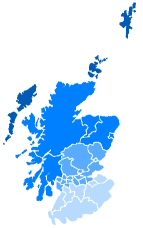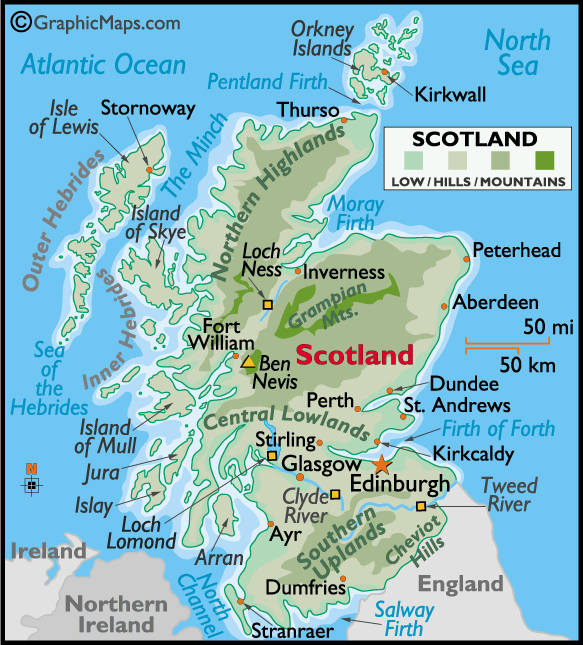1. Overview
2. Economy
Scotland
(78,790 sq km) is slightly smaller than Hungary. It is
the most northerly of the four parts of the United Kingdom, covering about one-third of the island of Great Britain. Scotland is bounded by
England to the south (separated from England by the Tweed River), the Atlantic
Ocean to the west and north, and the North Sea to the east. The capital is
Edinburgh and the largest city is
Glasgow. Scotland is a country with large areas of unspoilt and wild
landscape, and many of the UK’s mountains. The western
Highland coast is intersected throughout by long, narrow sea lochs, or fjords. Scotland also includes the Outer and Inner Hebrides and other islands off the
west coast and the Orkney and Shetland Islands off the north coast; together
more than 790 smaller islands. St.
Kilda (see:
World
Heritage Sites in the UK) is the most remote of all the inhabitable Scottish islands, being
over 160 km (100 miles) from the mainland.
covering about one-third of the island of Great Britain. Scotland is bounded by
England to the south (separated from England by the Tweed River), the Atlantic
Ocean to the west and north, and the North Sea to the east. The capital is
Edinburgh and the largest city is
Glasgow. Scotland is a country with large areas of unspoilt and wild
landscape, and many of the UK’s mountains. The western
Highland coast is intersected throughout by long, narrow sea lochs, or fjords. Scotland also includes the Outer and Inner Hebrides and other islands off the
west coast and the Orkney and Shetland Islands off the north coast; together
more than 790 smaller islands. St.
Kilda (see:
World
Heritage Sites in the UK) is the most remote of all the inhabitable Scottish islands, being
over 160 km (100 miles) from the mainland.
 Scotland
may be divided into three main geographical areas: the
Southern
Uplands;
the
Central
Scotland
may be divided into three main geographical areas: the
Southern
Uplands;
the
Central

Scotland's climate is temperate oceanic (mérsékelt óceáni) - warmed by the Gulf Stream. Generally, Scotland is cool, damp and cloudy, but daily weather is unpredictable and extremely changeable. January and February are the coldest months, averaging 5°C to 7°C, and summer has average temperatures of 19°C during its warmest months of July and August. Scottish weather is on average cooler than that of England. The east coast experiences more sunshine, but colder winters, compared to the west. Rainfall varies widely: The western highlands of Scotland are the wettest places, with annual rainfall exceeding 3,000 mm. In comparison, much of lowland Scotland receives less than 800 mm annually.
Just over 5 million people live in Scotland (5,094,800; 2005 est.), three-quarters of them in the central lowlands where two of its largest cities are situated: Edinburgh (the capital) on the east coast and Glasgow on the west. Aberdeen and Dundee are its two other principal cities. Together these four cities and their surrounding regions account for 75% of Scotland’s Gross Domestic Product (GDP). Scotland’s population has changed relatively little in the last 50 years. In June 2000 the estimated population was 5.1 million, compared with 5.2 million in 1971 and 5.1 million in 1951. The population density is the lowest in the UK, averaging 65 people per sq km (In England it is 383 people per sq km) but on the Highlands it is only 8 people per sq km.
In the last 50 years the Scottish economy has moved away from the traditional industries of coal, steel and shipbuilding. Extraction of offshore oil and gas, growth in services and, more recently, developments in hightechnology industries - such as chemicals, electronic engineering and information technology - have taken their place. Manufacturing still remains important producing exports valued more than £18 billion. Key features of the Scottish economy include:
Electronics. Scotland has one of the biggest concentrations of the electronics industry in Western Europe. Electrical and instrument engineering exports are accounting for more than 50% of Scotland’s manufactured exports which is 70% of the total Scottish export.
Oil and gas. Offshore oil and gas production has made a significant contribution to the Scottish economy in the last 30 years. Many of the UK’s 115 offshore oilfields are to the east of the Isles of Shetland and Orkney or off the east coast of the mainland.
Whisky. Whisky production continues to be important to Scotland. The value of drinks exports, dominated by whisky, is valued over £1 billion per year. There are 90 whisky distilleries in Scotland, most of them in the north-east.
Tourism. Tourism is a major industry, supporting about 200,000 jobs. The expenditure by tourists is valued around £4 billion and there are more than 20 million tourist trips per year, including those originating in Scotland.
Forestry. Scotland accounts for just under half of the UK’s timber production. In the last ten years there has been significant international and local investment in wood-based panel production and in pulp and paper processing. 75% of Scotland's land area is under some form of agricultural production.
Fishing. Fishing remains significant, particularly in the north-east and in the Highlands and Islands. In 2000 Scotland accounted for 70% by weight and 60% by value of the fish landed in the UK by British trawlers. Fish farming, particularly of salmon (lazac), has grown in importance; Scotland produces the largest amount of farmed salmon in the EU.
Infrastructure in Scotland is varied in its provision and its quality. The densest network of roads, railways and motorways is concentrated in the Central Lowlands of the country where around 70% of the population live. The rail network is primarily centred also here and is used principally as a means of public transport.
Edinburgh, the capital city of Scotland, is
situated on the east coast of Scotland's central lowlands on the south shore
of the Firth of Forth. Edinburgh is the seat of the Scottish Parliament. The
city is the single most important tourist destination in Scotland, and
Britain's most popular destination after London. The Old Town and New Town
districts of Edinburgh are
World Heritage
Sites. The city has several thousand buildings that
are officially protected because of their architectural or historic
importance. The dominating place of interest is the Edinburgh Castle and the
Royal Mile connecting the Castle Rock with Holyrood Palace. Two other major
attractions in the city are the Royal Botanic Garden and Edinburgh Zoo.
Edinburgh is well known for the annual Festival, the associated Festival
Fringe the largest performing arts festival in the world.
Glasgow is Scotland largest city
on the river
sources:
National Statistics, UK 2002, The Official Yearbook of Great Britain and Northern Ireland
Wikipedia, Economy of Scotland
Microsoft Encarta Encyclopedia Plus 2004
credits:
The text was composed by using the relevant materials of...
1. The Official Yearbook of Great Britain and Northern Ireland © Crown Copyright 2001.
2. About Glasgow © Glasgow City Council 2005
3. Economy of Scotland: Wikipedia The Free Encyclopedia under GNU Free Documentation Licence.